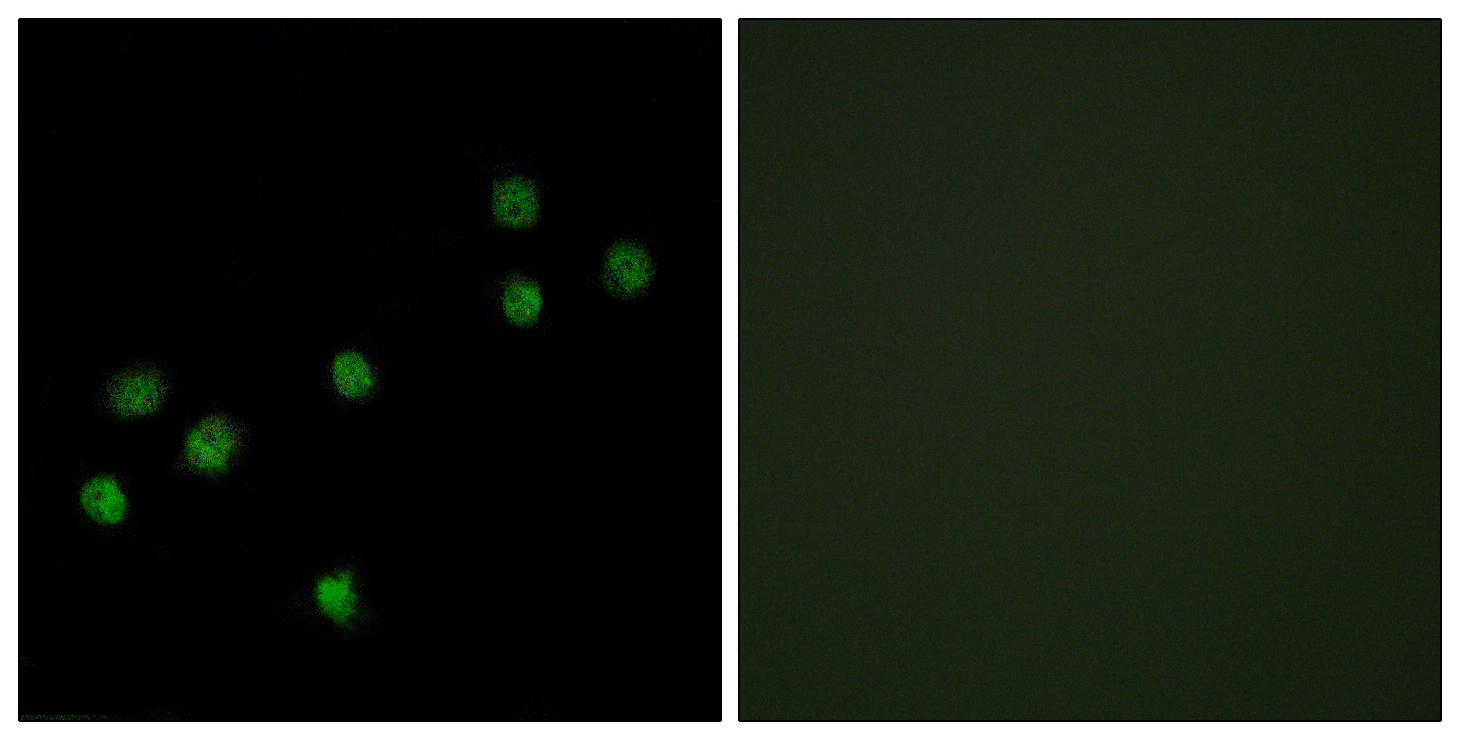CENP-A Polyclonal Antibody
- Catalog No.:YT0853
- Applications:IHC;IF;ELISA
- Reactivity:Human;Rat;Mouse;
- Target:
- CENP-A
- Gene Name:
- CENPA
- Protein Name:
- Histone H3-like centromeric protein A
- Human Gene Id:
- 1058
- Human Swiss Prot No:
- P49450
- Mouse Swiss Prot No:
- O35216
- Immunogen:
- The antiserum was produced against synthesized peptide derived from human Centromeric Protein A. AA range:1-50
- Specificity:
- CENP-A Polyclonal Antibody detects endogenous levels of CENP-A protein.
- Formulation:
- Liquid in PBS containing 50% glycerol, 0.5% BSA and 0.02% sodium azide.
- Source:
- Polyclonal, Rabbit,IgG
- Dilution:
- IHC 1:100 - 1:300. IF 1:200 - 1:1000. ELISA: 1:10000. Not yet tested in other applications.
- Purification:
- The antibody was affinity-purified from rabbit antiserum by affinity-chromatography using epitope-specific immunogen.
- Concentration:
- 1 mg/ml
- Storage Stability:
- -15°C to -25°C/1 year(Do not lower than -25°C)
- Other Name:
- CENPA;Histone H3-like centromeric protein A;Centromere autoantigen A;Centromere protein A;CENP-A
- Molecular Weight(Da):
- 16kD
- Background:
- Centromeres are the differentiated chromosomal domains that specify the mitotic behavior of chromosomes. This gene encodes a centromere protein which contains a histone H3 related histone fold domain that is required for targeting to the centromere. Centromere protein A is proposed to be a component of a modified nucleosome or nucleosome-like structure in which it replaces 1 or both copies of conventional histone H3 in the (H3-H4)2 tetrameric core of the nucleosome particle. The protein is a replication-independent histone that is a member of the histone H3 family. Alternative splicing results in multiple transcript variants encoding distinct isoforms. [provided by RefSeq, Nov 2015],
- Function:
- disease:Antibodies against CENPA are present in sera from patients with autoimmune diseases that developed autoantibodies against centrosomal proteins.,domain:The CATD (CENPA targeting domain) region is responsible for the more compact structure of nucleosomes containing CENPA and is necessary and sufficient to mediate the localization into centromeres.,function:Histone H3-like variant which exclusively replaces conventional H3 in the nucleosome core of centromeric chromatin at the inner plate of the kinetochore. Required for recruitment and assembly of kinetochore proteins, mitotic progression and chromosome segregation. May serve as an epigenetic mark that propagates centromere identity through replication and cell division.,PTM:Phosphorylation of Ser-7 by Aurora-A/STK6 and Aurora-B/STK12 during prophase is required for localization of Aurora-A/STK6 and Aurora-B/STK12 at inner centrome
- Subcellular Location:
- Nucleus . Chromosome, centromere, kinetochore . Chromosome, centromere . Localizes exclusively in the kinetochore domain of centromeres. Occupies a compact domain at the inner kinetochore plate stretching across 2 thirds of the length of the constriction but encompassing only one third of the constriction width and height (PubMed:19114591). Phosphorylation at Ser-68 during early mitosis abolishes association with chromatin and centromeres and results in dispersed nuclear location (PubMed:25556658). .
- Expression:
- Epithelium,Uterus,
- June 19-2018
- WESTERN IMMUNOBLOTTING PROTOCOL
- June 19-2018
- IMMUNOHISTOCHEMISTRY-PARAFFIN PROTOCOL
- June 19-2018
- IMMUNOFLUORESCENCE PROTOCOL
- September 08-2020
- FLOW-CYTOMEYRT-PROTOCOL
- May 20-2022
- Cell-Based ELISA│解您多样本WB检测之困扰
- July 13-2018
- CELL-BASED-ELISA-PROTOCOL-FOR-ACETYL-PROTEIN
- July 13-2018
- CELL-BASED-ELISA-PROTOCOL-FOR-PHOSPHO-PROTEIN
- July 13-2018
- Antibody-FAQs
- Products Images

- Immunofluorescence analysis of HepG2 cells, using Centromeric Protein A Antibody. The picture on the right is blocked with the synthesized peptide.

- Immunohistochemistry analysis of paraffin-embedded human breast carcinoma tissue, using Centromeric Protein A Antibody. The picture on the right is blocked with the synthesized peptide.



